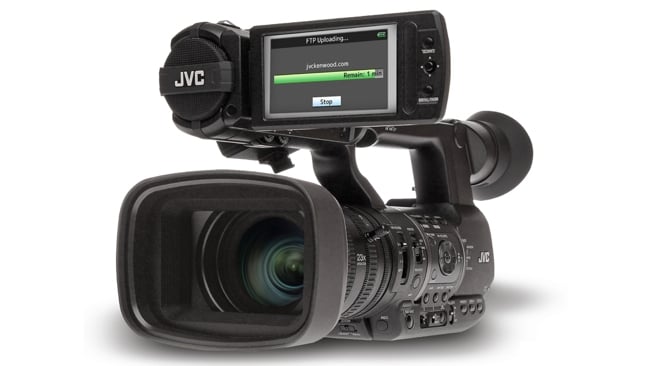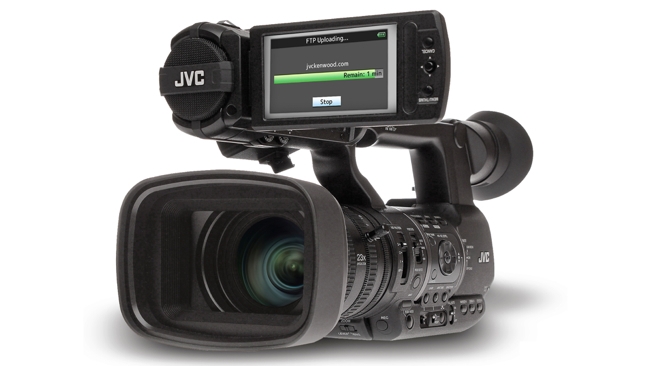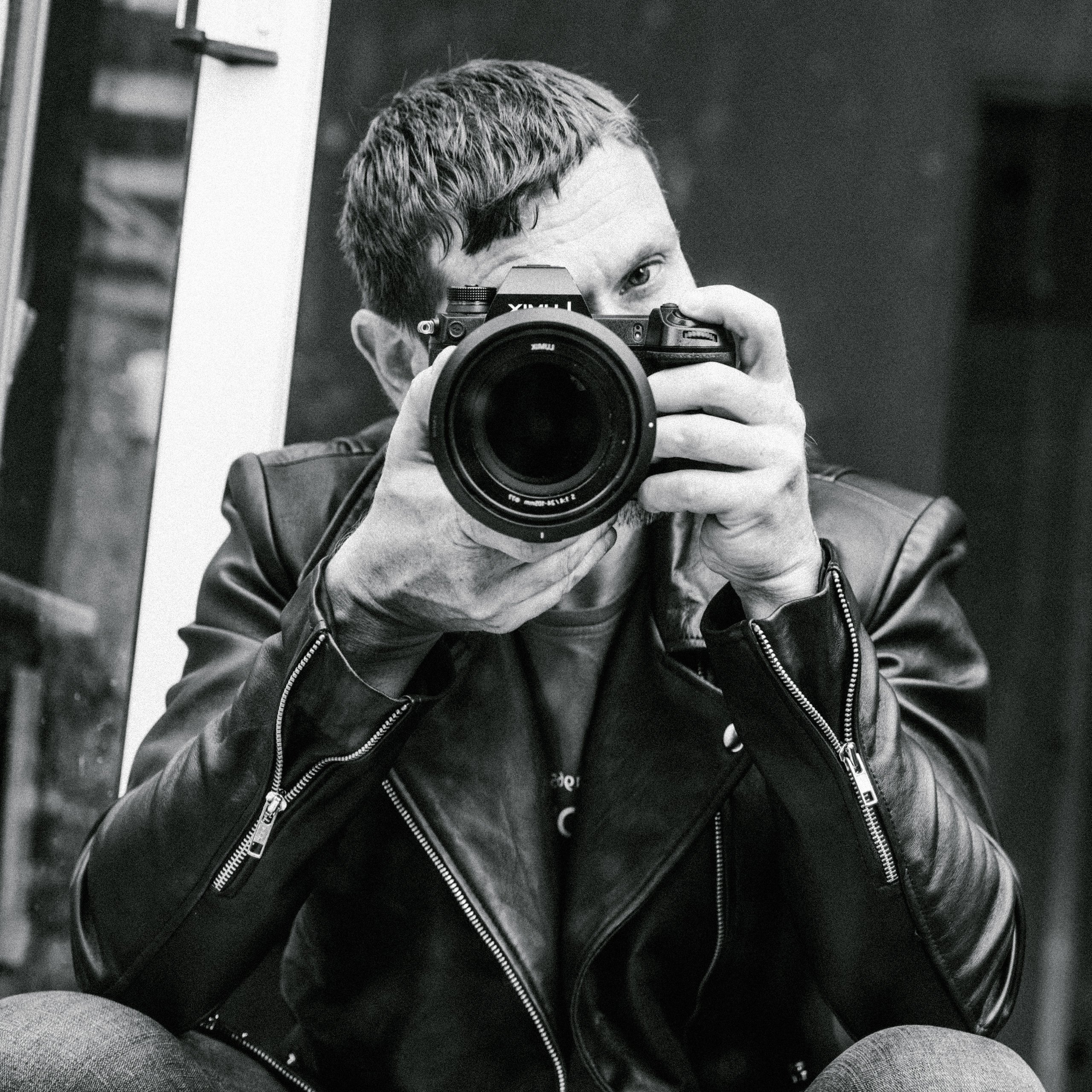
 GY-HM650
GY-HM650
The JVC GY-HM650 is in several ways an important camera. It can record to two codecs simultaneously, and can stream over 3G/4G mobile and and WiFi. And the BBC loves them enough to have placed a very large order. Here's our in-depth review
A few years back if you witnessed a media scrum you would see a combination of DSLR’s for stills shooters competing with the video guys armed with shoulder mounted 2/3” ENG battering rams.
Favoured for their ergonomics and robustness it has to be said that it is hard to beat a full sized ENG camcorder for versatility and speed of working. In an age of miniaturisation they may look to the untrained eye like cameras from times gone by, but technologically they were often way ahead of their smaller cousins.
The Sony EX series changed all of that, and now it is not unusual to see just as many smaller video cameras being shoved up against prison van windows and precariously poised over the heads of scandal-afflicted politicians instead. The sheer number of media organisations that exist now who use video coverage has meant that the market for smaller, relatively inexpensive, news capable cameras has boomed.
Advances in picture quality have meant that such cameras can be used quite happily across a number of production types while still producing a picture that is not compromised too much - if at all.
The GY-HM650
JVC, long respected for their GY-HM700 range of cameras, have released two handheld style 1/3” chip camcorders designed specifically for the journalistic market, the GY-HM600, and the focus of this review the GY-HM650.
On paper the 3-chip HM650 has some attractive specifications. One of the stand out features that JVC are pushing is the cameras ability to record two separate formats to each of the two card slots, or alternatively to record a direct mirrored backup of your footage.
The 650 comes with a Fujinon-designed lens with control rings for focus, focal length, and aperture. This lens is capable of a bright f/1.6 at the widest end of things, dropping down to f/3 at the narrowest focal length. The focal length range goes from 4.1mm - 93.4mm (equivalent to 29 - 667mm on a 35mm camera). That’s a nice big range, and so refreshing after the limitations of using DSLR lenses.
My initial impressions of the 650 were good. It feels robust with a good weight, and the buttons for the various features are a good size. The inclusion of optical ND filters was also a good sign.
Flip-out display
The camera has a flip-out 3.5” LCD display mounted near to the built in stereo mic on the top handle. With regard to build quality the LCD display hinge is possibly the 650’s weakest point. The number one breakage on Sony’s old workhorse, the Z1, used to be the LCD snapping off. I fear that this may well be the case and I feel that it may not withstand the assortment of knocks that it is likely to encounter during heavy journalistic use.
That point aside the LCD is bright and clear with good resolution and colour. While JVC have given the option of “Focus Assist” in the form of a coloured outline to help determine when things are in focus, they have thankfully also included a proper peaking adjustment too. In my opinion a far better and more reliable way of determining focus, and thus it is a very welcome inclusion.
The eyepiece viewfinder is placed at the rear of the camera, and it too has good colour and resolution for the size. Personally with this type of camera I always find myself using the main LCD rather than the rear mounted viewfinders due to ergonomics and reasons of comfort.
Present and correct are physical metal switches for white balance and gain. There are two main record buttons, one behind the usual hand grip and one on the top handle. When the camera is tripod-mounted this positioning of the record start/stop buttons is not too helpful, and so JVC have taken a cue from the 650’s shoulder-mount brethren and have usefully included an additional record button on the front of the body just below the lens.
Connectivity includes HD/SDI out, a full size HDMI out, headphone output, DC input, AV out, LANC, timecode link, and USB. The 650 also comes fitted with a GPS for laying down location metadata.
Completing the package are two audio XLR inputs with the usual assortment of mic/line switches, power, manual audio level control, and input selection.
Using the camera
Start up time for the 650 is very fast, so there isn’t much waiting around before you can start recording. This is essential given the market that the camera is aimed at. It's an often overlooked ability, but one that has eliminated cameras from the running from media organisations in the past.
There are a number of options for recording, including Sony’s Long GOP MPEG2 EX format in an MP4 wrapper up to 35mb/s, H264 at 35Mb/s in .MOV form, as well as AVCHD and MXF formats at an assortment of resolutions and frame rates.
1920x1080, 1440x1080, and 1280x720 are all available in both 50hz and 60hz variations, with 720p modes catering up to 60fps. Listing all the combinations would take forever, but the camera is capable of recording both interlaced and progressive scan modes from 23.94 to 25/30p and 59.97/50i in 1080 resolution modes depending on the codec that you have selected. While in 720 modes you can expect 23.98/25/29.97/50/59.94p.
If this wasn’t enough there are also options to record in SD resolutions as well as highly compressed proxy files.
As I mentioned earlier you can dual-record these formats to the two SD card slots. You have the option of dual recording as a backup, or recording certain alternative formats such as proxy files for fast web uploading for example.
There are limitations to this. For example you cannot record 1080/25p to one slot while simultaneously recording 720/60p to the other. The main purpose of the dual recording is for backup or to allow lower resolution versions of the footage to be recorded for faster uploading to servers for breaking news for example.
This dual recording option is not just limited to laying down footage onto SD cards. The 650 has another trick up its sleeve in the form of live streaming over wifi. You can also transfer footage to a remote server too. I was unable to test this function myself because a separate wifi or 3G/4G adaptor is required.
However in theory this means that a journalist could record footage and then transfer either the proxy files, or even the full HD footage directly back to base without the need of a laptop or other equipment, even if they might still be standing in the middle of a street somewhere.
Wifi is extended to smart phone connectivity too, with the ability to log footage, add metadata and the like.
Maximum bitrate
One puzzlement I have is why there is no 4:2:2 50Mb/s option. With other main manufacturers offering this on many of their rivals to this camera, it is puzzling as to why JVC have decided to leave this out, although you can use it with an external recorder to capture in (e.g.) ProRes.
A highly useful feature is the cache record. This is one of the best features to arrive in cameras ever since tapeless systems first came into being. The 650 allows a quite generous 20 second pre-record cache.
For those who have been living on a far away planet for the last few years, the pre-record function allows footage from 20 seconds before pressing the record button to be laid down to the card. Handy for those moments that catch you by surprise, as long as your camera was pointing at the subject in the first place! Such functions are highly useful where an interview subject who isn’t used to being on camera starts to speak without much warning. You can then ensure you captured the beginning of the sentence without interrupting their flow.
While it is nice to see a Fujinon lens on the 650 it is not without its drawbacks. Those expecting a Sony PMW series level of control will be disappointed. The lens on the 650 has pretences of being fully manual. It is in fact servo controlled with no end stops on the rings.
The fast ones amongst you will be quick to point out that the lens on the Sony PMW-200 for example is in reality also servo controlled. This is true of course, but they respond so quickly and smoothly that you would never know.
The biggest problem with the lens on the 650 is the servo response time. The zoom control for example suffers from quite high resistance, and, yes, I did make sure it was in manual mode! Fast, accurate focal length adjustments are difficult because it takes a while for the servo catch up due to it having a fairly low maximum speed.
The other controls, the focus and the iris, are OK, but the servo sluggishness is something you should be aware of if you prefer manual control.
Now, whether or not these will be issues that will affect the main type of operator who will use the camera is debatable. Although for someone like me who always uses lenses manually I would prefer at the very least a faster servo response time to make snap changes in framing much easier.
Good sharpness
Optically the lens is generally very good with good sharpness, although at some apertures there can be some quite noticeable chroma aberration. In all fairness I have this issue with many expensive ENG lenses as well, so this is far from being the sole preserve of the 650. Having said that, because it is a fixed lens camera it would be good to see if JVC can implement built in correction for such issues in future models.
In all, the camera produces a very pleasing, natural picture. Colour appears accurate with no nasties to speak of, and aliasing also seems well controlled. When the camera arrived the knee was set to 100%, so I lowered this slightly. While the camera will never have the contrast handling of the bigger chip cameras, I am pleased to say that the 650 handles things in a pleasing way with the highlight roll off looking very natural.
As with all small chip cameras you do have to be careful with the aperture that you use. Anything above f/5.6 and the effects of diffraction become noticeable with the picture starting to soften. Thankfully the inclusion of optical ND filters helps to control this in a versatile way, and the auto iris, should you be that way inclined, also includes an option to impose a limit on the maximum f/stop to use.
When exposed carefully detail is very good even with the detail turned fully off.
Noise is also well controlled. At high gains things do become a little messy, but this is to be expected. At normal settings, and low gains, the camera is pleasingly quiet. I couldn’t find a control to adjust the noise reduction amounts, but from what I can see the reduction that is in place does not affect the picture in an adverse way.
There is a function called LoLux available, which JVC says is for use in adverse lighting conditions. I am not fully clear as to what this mode achieved over and above the usual gain settings, and it did look fairly noisy when engaged. Something to consider only in the most trying of circumstances when getting footage in the first place takes precedence over quality.
Picture control
There are a number of adjustments available for picture control, including an intuitive colour matrix setting, knee, detail, master black, black toe etc. These adjustments do not have quite the fine variation available on pricier cameras, but it is good to see them here.
Flashband compensation is also available, which with camera flashes going off all around you will be quite a useful function to have available.
Zebra assist for exposure is available at two levels, and it is here that I have another small gripe. The stripe pattern for both zebras is exactly the same, and therefore it was confusing as to which part of the exposure I was looking at. You cannot turn off each zebra independently, and therefore you have no choice but to have both zebras turned on or have them both turned off. This is something that could be rectified with a firmware update.
My last main gripe is with the cooling fan. This starts up as soon as the camera is powered on and it is fairly noticeable. I can see it possibly causing issues in close proximity settings in quiet rooms. In most situations it may not be a problem, but it is something to be aware of.
Battery life was very good, lasting a number of hours. You will need a third party charger though because the supplied system will only charge the battery when it is connected to the camera.
On a final note I should comment on the auto functions of the camera. I would not normally use these, but I know from various seminars in the past that there are a good many people who are auto advocates!
The 650s auto response times are quick. Auto focus, once locked on, tracks subjects very cleanly for the most part. I briefly handed over the reigns to a colleague to track some subjects at the Cardiff International White Water centre. Despite the bright sunshine and the glistening water, usually a recipe for disaster with auto settings, the camera handled the situation very well. Once I dialled-in a bit of exposure compensation even the auto iris produced a good, even exposure. I am loathe to admit that it probably did as good a job as I would have done on manual!
Conclusions
This is a hotly contested market segment with a number of similarly priced rivals. While the JVC lacks 50Mb/s recording it does offer on the barrel lens controls that are not available on much of the competition, and the dual recording option is an attractive and useful feature for its intended market. We should not forget that the 650 is aimed primarily at journalism, although it may also be an attractive option for some corporate and industrial video producers too, and this factors into my conclusions.
The BBC has put in for a large order of 650s and so clearly feels that it offers something above the competition. The compatibility with Sony’s XDCAM EX series is an advantage, as is the fact that it can also record AVCHD, making it a versatile camera to use if you need to cater for a few different NLE requirements.
Battery life is very good, and the overall picture quality that you get for the money also makes the 650 worthy of thought.
All in all, if you are on a budget, and especially if you need a fast, easy to work with camcorder, but do not require 50Mb/s recording then the GY-HM650 should be a worthy contender in your considerations.
Tags: Production


Comments